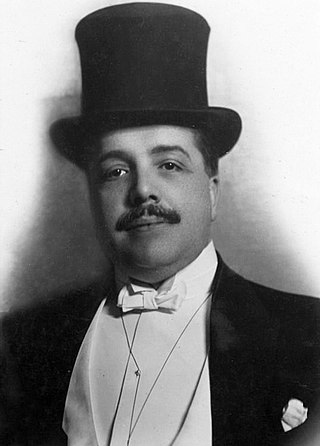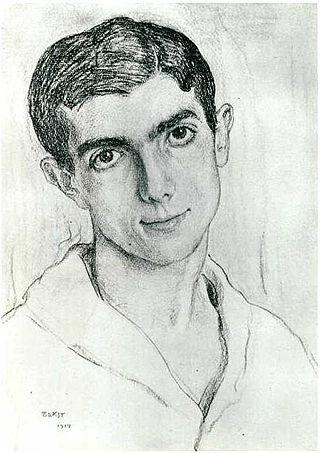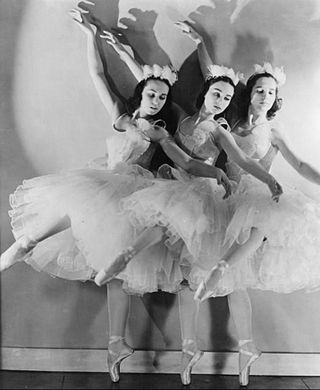
Sergei Pavlovich Diaghilev, also known as Serge Diaghilev, was a Russian art critic, patron, ballet impresario and founder of the Ballets Russes, from which many famous dancers and choreographers would arise.

Parade is a ballet choreographed by Leonide Massine, with music by Erik Satie and a one-act scenario by Jean Cocteau. The ballet was composed in 1916–17 for Sergei Diaghilev's Ballets Russes. The ballet premiered on Friday, May 18, 1917, at the Théâtre du Châtelet in Paris, with costumes and sets designed by Pablo Picasso, choreography by Léonide Massine, and the orchestra conducted by Ernest Ansermet.

René Blum was a French Jewish theatrical impresario. He was the founder of the Ballet de l'Opéra at Monte Carlo and was the younger brother of the Socialist Prime Minister of France, Léon Blum. A Jew, he was interned in various camps from 1941 until he was murdered by the Nazis at the Auschwitz concentration camp in late September 1942. While at the camps, he was known for keeping up the spirits of his fellow prisoners with tales of his life in the arts.

Vassily Grigorievich Voskresensky, usually referred to as Colonel Wassily de Basil, was a Russian ballet impresario.

Leonid Fyodorovich Myasin, better known in the West by the French transliteration as Léonide Massine, was a Russian choreographer and ballet dancer. Massine created the world's first symphonic ballet, Les Présages, and many others in the same vein. Besides his "symphonic ballets," Massine choreographed many other popular works during his long career, some of which were serious and dramatic, and others lighthearted and romantic. He created some of his most famous roles in his own comic works, among them the Can-Can Dancer in La Boutique fantasque (1919), the Hussar in Le Beau Danube (1924), and, perhaps best known of all, the Peruvian in Gaîté Parisienne (1938). Today his oeuvre is represented by his son Lorca Massine, who stages his works around the world.

The Ballets Russes was an itinerant ballet company begun in Paris that performed between 1909 and 1929 throughout Europe and on tours to North and South America. The company never performed in Russia, where the Revolution disrupted society. After its initial Paris season, the company had no formal ties there.

The company Ballets Russes de Monte-Carlo was formed in 1932 after the death of Sergei Diaghilev and the demise of Ballets Russes. Its director was Wassily de Basil, and its artistic director was René Blum. They fell out in 1936 and the company split. The part which de Basil retained went through two name changes before becoming the Original Ballet Russe. Blum founded Les Ballets de Monte Carlo, which changed its name to Ballet Russe de Monte Carlo when Léonide Massine became artistic director in 1938. It operated under this name until it disbanded some 20 years later.
A danseur noble traditionally was a male ballet dancer who projected great nobility of character. Over the last century, the term has been used to define a male principal dancer who performs at the highest theatrical level combining grace with ability. Some use danseur noble as the masculine equivalent to a Prima Ballerina, or to refer to the male partner of a ballerina during a pas de deux.
The Original Ballet Russe was a ballet company established in 1931 by René Blum and Colonel Wassily de Basil as a successor to the Ballets Russes, founded in 1909 by Sergei Diaghilev. The company assumed the new name Original Ballet Russe after a split between de Basil and Blum. De Basil led the renamed company, while Blum and others founded a new company under the name Ballet Russe de Monte-Carlo. It was a large scale professional ballet company which toured extensively in Europe, Australia and New Zealand, the United States, and Central and South America. It closed down operations in 1947.
La Boutique fantasque, also known as The Magic Toyshop or The Fantastic Toyshop, is a ballet in one act conceived by Léonide Massine, who devised the choreography for a libretto written with the artist André Derain, a pioneer of Fauvism. Derain also designed the décor and costumes for the ballet. Ottorino Respighi wrote the music based on piano pieces by Gioachino Rossini. Its world premiere was at the Alhambra Theatre in London on 5 June 1919, performed by Sergei Diaghilev's Ballets Russes.

Chout, Op. 21, is a ballet by Sergei Prokofiev. It was originally composed in 1915, then extensively revised at the request of Serge Diaghilev in 1921. The composer extracted an orchestral suite from it, Op. 21 bis. The ballet's full title is Tale of the Jester Who Outwits Seven Other Jesters. The most commonly used title for the work is based on the French transliteration of the Russian word for "jester", shut.
Nobilissima visione is a 50-minute ballet in six scenes by Paul Hindemith, originally choreographed by Léonide Massine for the Ballet Russe de Monte Carlo. The libretto by Hindemith and Massine depicts episodes from the life of Saint Francis of Assisi. The work was completed in February 1938 and premiered at Theatre Royal, Drury Lane in London on 21 July 1938, with sets and costumes by Pavel Tchelitchew and under the baton of the composer. He led one performance of the new ballet at the Metropolitan Opera House in New York on 14 October of the same year.
Colon Theater Ballet is a ballet company based in Buenos Aires, Argentina. The company is attached to the Colon Theater, which is also home to the Buenos Aires Philharmonic orchestra and the Colon Theater Opera company. It was established in 1925 and is the oldest ballet company in South America.
The Gay Parisian is an American short film produced in 1941 by Warner Bros. and directed by Jean Negulesco. The film is a screen adaptation, in Technicolor, of the 1938 ballet Gaîté Parisienne, choreographed by Léonide Massine to music by Jacques Offenbach. It was nominated for an Academy Award at the 14th Academy Awards for Best Short Subject (Two-Reel).

Mercure is a 1924 ballet with music by Erik Satie. The original décor and costumes were designed by Pablo Picasso and the choreography was by Léonide Massine, who also danced the title role. Subtitled "Plastic Poses in Three Tableaux", it was an important link between Picasso's Neoclassical and Surrealist phases and has been described as a "painter's ballet".
Ursula Moreton was a British ballerina and teacher, director of the Royal Ballet School from 1952 to 1968.

Nathalie "Natasha" Krassovska (1918–2005) was a Russian born prima ballerina and teacher of classical ballet most noted for her work with the Ballet Russe de Monte Carlo. Following her decades-long career, she moved to the U.S., where she founded the Krassovska Ballet Jeunesse. Krassovska taught, choreographed and performed until her death.

Soleil de Nuit, was a 1915 ballet by Léonide Massine at the Ballets Russes. It was set to Rimsky-Korsakov's music from The Snow Maiden. Sets and costumes were by Mikhail Larionov.
Les Présages is a ballet choreographed by Léonide Massine to music from Tchaikovsky's Symphony No. 5, with sets and costumes by André Masson. The premiere was performed on 13 April 1933 at the Opéra de Monte Carlo by the Ballets Russes de Monte-Carlo.
Lorca Massine is an American choreographer and dancer, born in New York on July 25, 1944, to Russian immigrant Léonide Massine, an accomplished choreographer and dancer. He studied dance with his father, Victor Gsovsky, Asaf Messerer and Anatole Wilzac. Over his career, he has collaborated with world-acclaimed choreographers such as Balanchine, Béjart, as well as his father.